The
Saree, also known as
Sari or
Shari is one of
India's Most Iconic Traditional Garments, known for its elegance, cultural significance and versatility.
It is a long piece of fabric, usually around
6 to
9 yards, draped in different styles across various regions of India. More than just
clothing, the saree represents heritage, craftsmanship and identity.
Each State in India has its own distinct saree style, from the rich
Banarasi Silk of Uttar Pradesh to the lightweight
Kasavu of Kerala. It is worn on different occasions, from daily wear to grand celebrations like weddings and
festivals.
The saree's adaptability makes it timeless, as it blends tradition with modern
fashion while remaining an integral part of
Indian Culture.
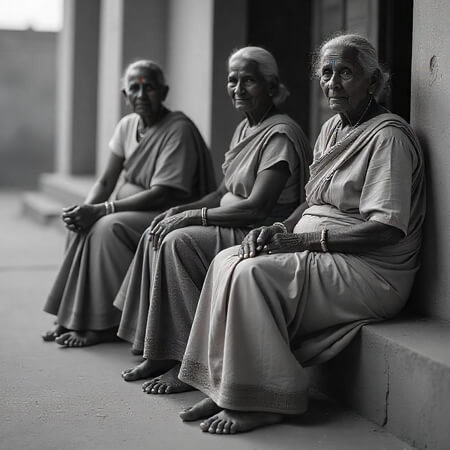
The saree has been an essential part of Indian culture for over
5000 Years. Its origins can be traced back to ancient texts like the Rigveda, where early references to unstitched draped garments are found. Sculptures from the Maurya and Gupta periods also depict women wearing long pieces of cloth wrapped elegantly around their bodies, similar to how sarees are worn today. During this time, stitched clothing was uncommon, and draped fabrics were the norm, offering comfort and versatility.
Over the centuries, the saree evolved with changing cultural and
fashion influences. During the Mughal period, luxurious fabrics like Silk and Muslin became popular, along with intricate embroidery that added a touch of grandeur. Later, in the British colonial era, sarees were paired with blouses and petticoats, a trend influenced by Victorian dressing norms. This was when the Nivi drape, now the most commonly worn style, gained prominence. Introduced by social reformer Jnanadanandini Debi, this draping style made sarees more practical and suited for public life.
Despite centuries of change, the saree has remained a timeless and adaptable garment. Whether in traditional weaves or modern designer styles, it continues to evolve while staying rooted in Indian heritage.
A saree is typically
5.5 to
9 metres long and around
44 to
48 inches wide. It consists of three main parts:
- Pallu is the decorative end that drapes over the shoulder. It often features embroidery, prints, zari work or embellishments, making it the most eye-catching part of the saree.
- Pleats are the folded sections tucked into the waist. They allow for ease of movement and create the signature draped look. The number and width of pleats depend on the draping style.
- Border runs along the entire length of the saree. It may be simple or heavily embroidered, adding structure and contrast to the overall design.
Understanding these elements helps in choosing a saree that
suits both personal style and occasion.
India is home to a diverse range of sarees, each with unique weaves, fabrics and techniques specific to its region. Here are some of the most iconic sarees from across the country.
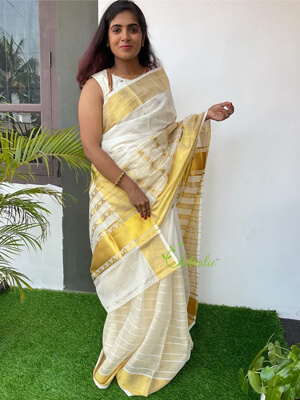
Balaramapuram Saree
Woven in Kerala, Balaramapuram sarees are known for their simplicity, fine cotton fabric and golden zari borders, making them a staple in traditional South Indian attire.
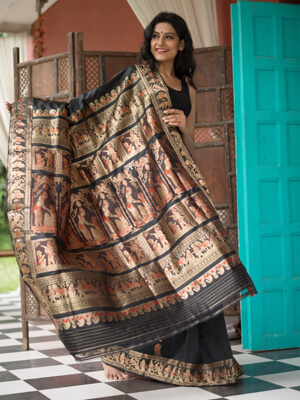
Baluchari Silk Saree
(Bengal's Storytelling Weave)
Baluchari sarees from Bengal are famous for their elaborate silk brocade work depicting mythological scenes, making them unique and artistic.

Banarasi Silk Saree
(The Queen of Silks)
Originating from Varanasi, Banarasi sarees are woven from fine silk and known for their intricate brocade work, zari patterns and Mughal-inspired motifs.
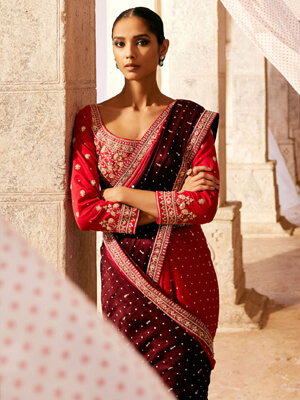
Bandhani Saree
(Gujarat & Rajasthan's Tie-Dye Wonder)
Bandhani sarees feature intricate tie-dye patterns in
vibrant colours, created by a traditional technique of plucking the fabric into small bindings before dyeing.
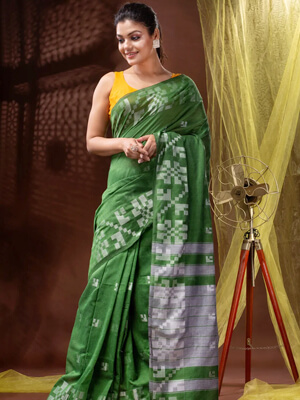
Bengal Cotton Saree
(Tant)
Tant sarees from Bengal are lightweight and breathable, with crisp cotton fabric and intricate thread work, perfect for daily wear.

Bomkai Saree
(Odisha's Artistic Weave)
Bomkai sarees, also known as Sonepuri sarees, are a combination of
ikat and embroidery, featuring intricate threadwork on the pallu and borders.
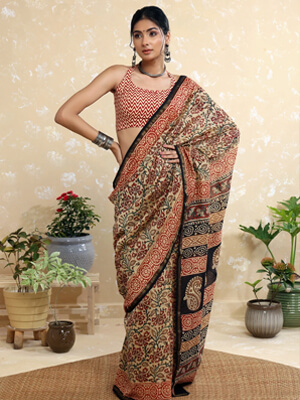
Chanderi Saree
(Lightweight & Elegant)
From Madhya Pradesh, Chanderi sarees are woven from silk, cotton or a blend of both. They are lightweight with a sheer texture and feature delicate motifs inspired by nature.
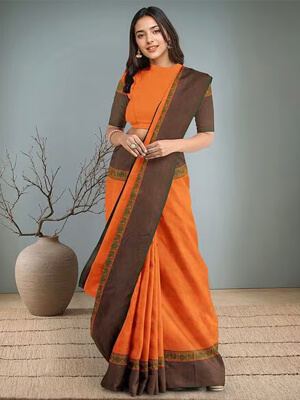
Chettinad Cotton Saree
(Tamil Nadu's Bold Weave)
Chettinad sarees are known for their striking colours, wide borders and durability, making them ideal for both casual and festive wear.
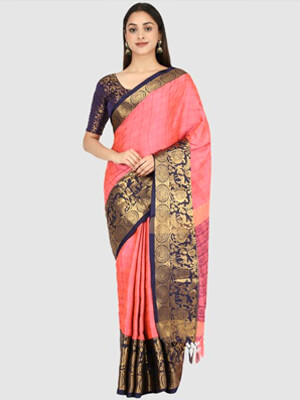
Chinnalapattu Silk Saree
(Tamil Nadu's Silk Legacy)
A lesser-known yet exquisite weave, Chinnalapattu silk sarees are woven with precision, featuring rich textures and elegant designs.

Dhakai Jamdani Saree
(Bangladesh & Bengal's Masterpiece)
Dhakai Jamdani sarees are handwoven with intricate patterns on a sheer cotton base, known for their lightweight feel and delicate craftsmanship.

Gadwal Saree
(Telangana's Silk-Cotton Blend)
Gadwal sarees feature a silk body with contrasting zari borders, offering a unique combination of comfort and grandeur.
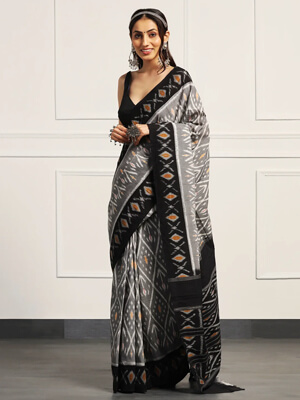
Ikat Saree
(A Play of Patterns)
Ikat sarees, popular in Odisha, Andhra Pradesh, and Gujarat, are known for their unique
resist-dyeing technique, which creates bold, symmetrical patterns.
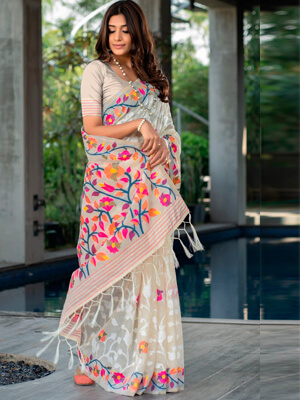
Jamdani Saree
(Bengal's Delicate Weave)
Jamdani sarees are made using a sheer cotton base with elaborate handwoven motifs that appear to float on the fabric. The weaving technique is complex & requires skilled craftsmanship.
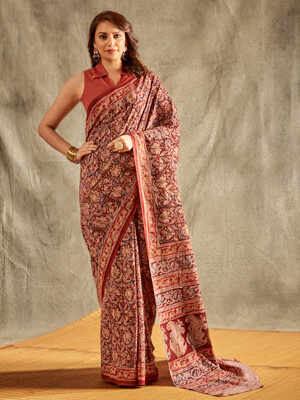
Kalamkari Saree
Kalamkari sarees are either block-printed or hand-painted with mythological and nature-inspired motifs, making them distinct pieces of art.
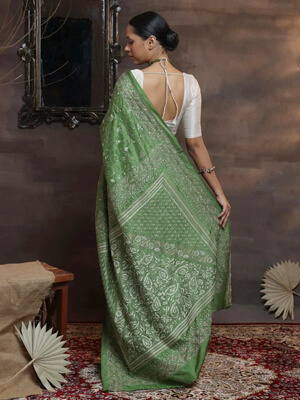
Kantha Saree
(Bengal's Embroidery Art)
Kantha sarees are decorated with beautiful hand-stitched embroidery, often featuring
floral or folk motifs.
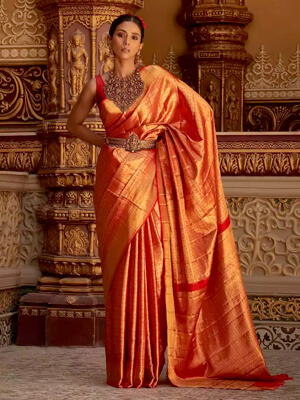
Kanjeevaram (Kanchipuram) Saree
(South India's Pride)
Kanjeevaram sarees, from Tamil Nadu are crafted from pure mulberry silk and are recognised for their rich colours, contrast borders and thick gold zari work.
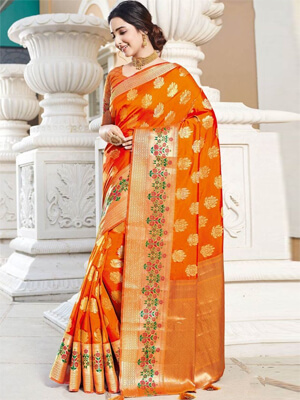
Konrad Saree
(Tamil Nadu's Temple Saree)
Konrad sarees are known for their wide borders and traditional motifs, often depicting deities and nature-inspired designs.

Kota Doria Saree
(Rajasthan's Lightweight Weave)
Kota Doria sarees are woven with a blend of cotton and silk, featuring a signature
checkered pattern. They are lightweight and ideal for hot weather.

Maheshwari Saree
(Madhya Pradesh's Subtle Elegance)
Maheshwari sarees have a silk-cotton blend with intricate woven borders, offering a perfect mix of tradition and modernity.

Mangalagiri Saree
(Andhra Pradesh's Crisp Weave)
Mangalagiri sarees are woven from fine cotton with a characteristic zari border and no embellishments, known for their durability and elegance.

Muga Silk Saree
(Assam's Golden Fabric)
Muga silk, exclusive to Assam, is famous for its natural golden sheen that becomes richer with time. It is one of the strongest silks and is traditionally handwoven.

Mysore Silk Saree
(Karnataka's Lustrous Silk)
Mysore silk sarees are made from pure silk with minimalistic zari work, offering a luxurious drape.

Narayanpet Saree
(Telangana's Checked Pattern)
Narayanpet sarees are identified by their checkered designs and contrasting borders, blending comfort with tradition.

Paithani Saree
(Maharashtra's Signature Weave)
Paithani sarees from Maharashtra are known for their vibrant colours, real gold or silver zari work, and distinctive peacock or floral motifs on the pallu.

Patola Saree
(Gujarat's Double Ikat Weave)
Created using a double ikat technique, where both warp and weft threads are dyed before weaving. This labor-intensive process results in precise, symmetrical patterns on both sides of the fabric.

Pochampally Saree
(Telangana's Ikat Tradition)
Pochampally sarees are known for their geometric ikat patterns and vibrant colours. The precision in weaving ensures a distinct symmetry in design.

Sambalpuri Saree
(Odisha's Ikat Masterpiece)
Sambalpuri sarees feature unique
tie-and-dye ikat patterns, where each thread is dyed before weaving. They often showcase mythological and nature-inspired designs.

Tussar Silk Saree
(Bihar & Jharkhand's Wild Silk)
Tussar silk sarees are lightweight and textured, known for their rich, natural gold hue and earthy appeal.

Uppada Saree
(Andhra Pradesh's Delicate Weave)
Uppada sarees are woven using the jamdani technique, known for their lightweight
silk fabric and intricate patterns.

Venkatagiri Saree
(Andhra Pradesh's Fine Cotton)
Venkatagiri sarees are woven from soft cotton and often have intricate jamdani-style motifs, making them ideal for warm climates.

Selecting the right saree fabric is essential for comfort and style. Different materials offer varying levels of breathability, drape and suitability for occasions. Here's a breakdown of common saree fabrics and their best uses.
- Silk - The Classic Choice :
Silk sarees, such as Banarasi, Kanjeevaram and Paithani, are luxurious and elegant. They are ideal for weddings, festivals and formal events due to their rich texture and sheen. However, they can be heavy and less breathable, making them less suitable for hot weather. - Cotton - Comfortable and Breathable :
Cotton sarees, like Bengal Taant and Kota Doria, are perfect for daily wear and office attire. They allow airflow, making them a great option for summer. However, they wrinkle easily and require frequent ironing. - Chiffon - Lightweight and Elegant :
Chiffon sarees drape well, offering a soft, flowy look. They are ideal for parties and casual gatherings. However, they are delicate and prone to snagging. - Georgette - Durable & Stylish :
Georgette sarees have a similar drape to chiffon but with added durability. They resist wrinkles and are suitable for formal and casual occasions alike. - Linen - Cool & Classy :
Linen sarees are breathable and comfortable, making them great for summer and daytime events. They have a textured appearance but wrinkle easily, adding to their natural charm. - Crepe - Modern & Chic :
Crepe sarees have a slightly crinkled texture, making them easy to manage and stylish. They are ideal for semi-formal and casual occasions. - Organza - Sheer & Structured :
Organza sarees are sheer and lightweight, offering a crisp, elegant drape. They are perfect for special events but require careful handling as they do not flow like chiffon or georgette.

Proper care ensures your sarees remain in excellent condition for years. Follow these simple steps to maintain their fabric, colour, and texture.
1.
Washing Tips - (Handwash v/s Dry Cleaning)
- Silk & Banarasi Sarees : Dry clean only. If washing at home, use cold water and mild detergent. Do not wring; gently squeeze out excess water and dry in shade.
- Cotton Sarees : Handwash separately in cold water with mild detergent. Starch before drying for a crisp look.
- Georgette, Chiffon & Crepe Sarees : Handwash in cold water with mild shampoo. Avoid scrubbing.
- Linen Sarees : Handwash in cold water with mild detergent. Iron when slightly damp.
- Embroidered & Heavy Sarees : Dry clean only. Steam ironing is preferable.
2.
Storage - (How to Keep Saree Safe)
- Folding : Fold along natural creases to avoid damage. Refold every few months.
- Fabric Protection : Wrap in muslin or cotton cloth to allow airflow and prevent moisture buildup.
- Avoid Plastic Covers : Plastic traps moisture, leading to mildew. Use cotton bags instead.
- Humidity Control : Store in a dry place. Use silica gel packets or neem leaves to absorb moisture.
- Silk & Heavy Sarees : Preferably roll instead of folding to prevent creases.
3.
Ironing - (Temperature Matters)
- Silk Sarees : Use a steam iron on low heat. Place a cotton cloth over the saree while ironing.
- Cotton Sarees : Use high heat with slight dampness for a crisp finish.
- Georgette & Chiffon Sarees : Use low heat to maintain texture.
- Linen Sarees : Iron when slightly damp for best results.
- Embroidered & Zari Sarees : Iron inside out with a cloth barrier to protect embellishments.
In conclulsion, despite changing
fashion trends, the saree continues to evolve, blending classic weaves with modern designs. From rich Banarasi silks to lightweight cottons, each saree tells a unique story of craftsmanship and heritage. There is no single way to wear a saree. Traditional drapes like the Nivi and Bengali styles showcase cultural roots, while contemporary pre-stitched and ruffle sarees add a modern touch. With endless fabric choices, colours and styling options, the saree remains relevant for every occasion - whether it's a wedding, office wear or casual outing.
Embrace the beauty of this classic attire, whether in its purest traditional form or with a modern twist. The saree will always be a wardrobe essential, effortlessly combining grace and style.




































 CONTACT USWaves Institute of Fashion Designing,
CONTACT USWaves Institute of Fashion Designing,